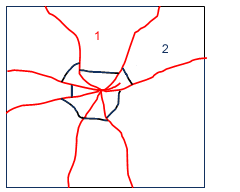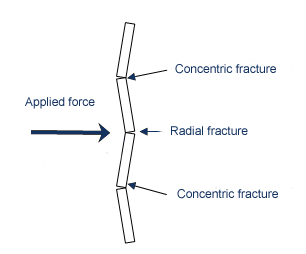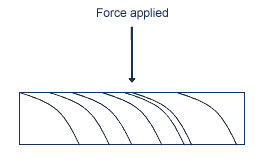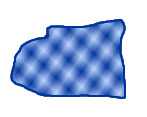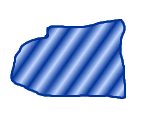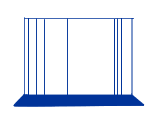| FORENSIC CASE STUDIES | ||
1) Murder in the MuseumInvestigate a mysterious crime! That is if you find yourself in Brussels, Belgium between December 14, 2006 and September 2, 2007! The Royal Belgian Institute of Natural Sciences is featuring an exhibit that showcases the various disciplines in Forensic Science and allows visitors to play the part of the investigator. FirearmsID.com is proud to have been able to help the museum in this exhibit by providing a custom interactive Virtual Comparison Microscope exercise to be an integral part of the "investigation". A screenshot of this custom VCM exercise can be seen by clicking the thumbnail image below. As visitors move through the exhibit they are presented with a crime scene, physical evidence and clues to help determine, "who killed the museum director?". At the Laboratory, museum patrons will attempt to correctly match cartridge case samples on the Virtual Comparison Microscope. If successful, a secret code is discovered that allows the visitors to continue on in the investigation. The museum's press release for the exhibit reads as:
Be sure to visit the museum's website at the address above to learn more about this exciting exhibit. We at FirearmsID.com are honored to have been able to play an important role in demonstrating to all of the would-be sleuths in Belgium and Europe the outstanding forensic discipline of Firearm and Toolmark Identification! I want to again thank Erik Dahlberg of Denmark for creating this awesome version of the FirearmsID.com Virtual Comparison Microscope for the museum. Erik has faithfully been an integral part of FirearmsID.com over the last several years and has contributed his time and talents without hesitation. Scott Doyle |
||
|
2) |
||
|
THE CASE OF BUNSEN BURNED:
Lab Results for
Evidence An investigation of the scene reveals an extensively burned region in the northwest corner of the kitchen where a badly damaged garbage can is found. Another extensively burned region is found in the entrance hall at the southwest corner of the building. Samples of charred debris are taken from both areas and submitted to the lab for testing. The window in the kitchen door is smashed in. Glass samples are collected from the kitchen floor and submitted to the lab. The house has been ransacked. The police cannot immediately determine what items may have been taken. The upstairs of the house is smoke damaged but did not sustain any structural damage. Among items collected is a lipstick stained tissue from the garbage can in the second floor bathroom. The victim is identified as Jeff Bunsen, the owner of the home. An autopsy reveals that Bunsen died of a contact gunshot wound to the head. A sample of blood is submitted to the lab for typing as is routine in an autopsy. An additional sample sent to the lab is concentrated down to one-fiftieth its original volume and will be tested for alcohol content as part of a routine toxicology screen. No significant blood level of carbon monoxide is detected. By interviewing neighbors, police turn up a number of leads in Mr. Bunsen's murder. Mrs. Kravitz, the nosy next door neighbor, tells police the Mr. Bunsen is estranged from his wife Marie. She is fairly certain that his housekeeper, Tess Lavoisier, has a key to his house. In addition, she reports having heard a loud argument earlier in the day when Mr. Bunsen was "keeping company with that other girl - she was, you know, his 'type'...a brunette of average height with a nice figure. He liked them that way." Mr. Dalton, the neighbor on the other side of Mr. Bunsen's, does not recall anything unusual during the day at the Bunsen residence. Some time after 8:00 pm, he remembers seeing a dark-haired woman of medium height and build leaving the Bunsen home. He says the woman looked a lot like Mrs. Bunsen, however, it was getting dark and he could not be absolutely positive it was her. It was shortly thereafter that he noticed the fire and called 911. Police quickly tracked down Mrs. Bunsen. She is a brunette of medium
height and build. They inform her of her husband's murder. She
appears stunned. She states that she last saw her husband Thursday evening
at his home. She says that her husband had been seeing another Ms. Lavoisier was also questioned by police. She stated that she did indeed have a key to Mr. Bunsen's home. At the time of the murder, she was attending a cousin's wedding in the next town. Her alibi checked out. She said that she cleaned the house from top to bottom every Friday afternoon as Mr. Bunsen liked to come home to a clean house on Friday nights. When asked if her cleaning included emptying the kitchen and bathroom garbage cans, she replied that it absolutely did. Police then questioned Ms. Avogadro. She is also a brunette of medium height and build. Ms. Avogadro is very pale and apologizes for her appearance. She says that she has been sick with the flu. When informed of Mr. Bunsen's death, she is visibly shaken. She states that Mr. Bunsen was a coworker but denies any romantic involvement with him. She has no alibi for the night of the murder. Ms. Avogadro tells the police that she really is not feeling well and asks them to leave. After questioning Ms. Avogadro and Mr. Bunsen's coworkers, the police find someone who has firsthand knowledge of a romantic involvement between the two. The police return to question Ms. Avogadro. They find her in her apartment, disoriented and shaking. An ambulance is called. Next to her bed is a glass containing a clear, colorless liquid as well as some white powder. The ambulance squad suspects a drug overdose. The police inform the EMT's that Ms. Avogadro claimed to have the flu the day before. She is transported to the hospital. The glass of liquid and the white powder are submitted to the toxicology lab for analysis. The police obtain warrants for the cars and homes of Mrs. Bunsen and Ms. Avogadro. Evidence is seized and submitted to the lab for analysis. A summary of evidence is as follows: A. Crime Scene B. Jeff Bunsen Autopsy C. Evidence from Marie Bunsen D. Evidence from Eva Avogadro 1. drinking glass with clear, colorless liquid Source: www.phy.duke.edu Forensic Handbook 2 – Trace Evidence Dr Allison Jones May 2002 The value of 'trace' (or 'contact') forensic evidence was first recognised by Edmund Locard in 1910 when he proposed his 'interchange theory'. It basically says that 'every contact leaves a trace'. For example, burglars will leave traces of their presence behind and will also take traces with them. They may leave hairs from their body or fibres from their clothing behind and they may take carpet fibres away with them. Two of the less obvious, but frequent, sources of forensic evidence are glass and paint traces. Case Study Paint fragments from a car in a Sudbury, Toronto scrapyard led to the arrest of a man who had been involved in a hit-and-run accident three years earlier. A young boy was hit by a car whilst he was riding his bicycle. The car didn't stop and the boy was left with serious head wounds. There were no witnesses. Three years later, police were conducting a routine check of scrapyards to see if they could find evidence of cars that may have been involved in crimes. Samples from a Chrysler Coronet matched paint fragments removed from the clothing of the young boy. This suggested they could have shared a common origin. The owner of the car was traced and this evidence was used against him in court. The man was charged with criminal negligence, causing bodily harm and failing to remain at the scene of an accident, and subsequently found guilty. Paint traces Paint is a common form of evidence presented to forensic scientists. It can provide valuable evidence that associates a suspect with a crime scene. It might be found on a crowbar, a window or door, on a hit-and-run victim's clothing, on vehicles in a traffic accident, or as flakes on clothing from a break-in entry point. The nature of paint Paint is made up of three main components. The carrier is usually polymeric in nature and 'cures' (becomes solid) on evaporation of the solvent. The solvent is usually an organic liquid that dissolves the carrier to produce a coating with a consistency suitable for a brush or roller. The solvent is rarely of any forensic value and will usually have long since evaporated. The pigment gives the colour. Commonly used pigments are titanium dioxide and zinc oxide for white, phthalocyanines for blue, zinc chromate for yellow and copper (I) oxide for red. Reading the signs Though visual examination and jigsaw-fitting are employed, paint samples are mainly studied with a range of techniques that analyse the carrier and pigment. As well as using microspectrophotometry to establish the colour, more in-depth techniques may also be used to establish the composition of the paint samples. Techniques include Fourier Transform Infrared Spectrometry (FT-IR), Pyrolysis Gas Chromatography (P-GC) and Scanning Electron Microscopy (SEM). The results of such analyses can provide information about what type of surface the paint came from. With car paint, the different layers can be analysed and, through a database, vehicle details may be learnt. Make, model and year of manufacture may be ascertained in this way. Also, comparison of samples may reveal links to a common origin. For example, a paint sample from the clothing of a hit-and-run victim will be compared with a sample taken from the suspect vehicle to see if they match. Glass traces Glass is one of the most common and important substances submitted to forensic science laboratories for analysis. It's frequently encountered at crime scenes, particularly those involving motor vehicle accidents, car theft and burglaries. This is due, in part, to the fact that windows are a common point of entry into buildings for burglars and large quantities of broken glass are produced in traffic accidents. Glass, fragments of which may remain on clothing for a long time, is very stable – it doesn't degrade like biological evidence and doesn't alter over time. The role of the forensic scientist analysing glass is to unequivocally establish the origin of the sample. In practice this involves comparing fragments obtained from a suspect with samples taken from the scene. Or comparing fragments obtained from the clothing of a hit-and-run victim with samples taken from a vehicle. How windows break When struck, flat glass breaks in a very specific way. Glass is weaker under tension than under compression so the window will break on the opposite side to the strike. Radial fractures form initially. These run out from the point of impact on the opposite surface to the applied force. Then concentric fractures form. These run between the radial fractures but on the same side of the glass as the impact.
Fractures formed following impact onto a piece of glass
Most of the glass is projected forward, in the direction of the blow. But some of the fragments will be projected backwards, towards the person breaking the window, up to a distance of 3 metres – known as 'backscatter'. Anyone standing close enough when the window breaks will be covered in tiny fragments of glass which will stick to their clothing and their hair. Reading the signs Most of the glass encountered by forensic scientists originates from windows, headlamps, bottles and containers. All this commercial glass is similar in composition and the usual methods of chemical analysis are of little help in distinguishing between them. The simplest method used to compare pieces of broken glass is to fit them together like a jigsaw, though this is rarely possible due to the small size of samples. However, large fragments of glass that originated from the point of impact do show characteristic 'rib' (or 'heckle') marks along the edges. And these marks can be used to determine the side on which the impact occurred and so help to reconstruct the window.
Edge of broken glass showing rib or heckle marks Patterns and marks on glass surfaces are also used in the reconstruction process. The surfaces of glass fragments can show characteristic scratch marks, revealing their origin. For example, windscreens can be scratched by windscreen wipers and side windows can be scratched by being wound up and down past abrasive particles.
From an area on a windscreen where the wiper blades cross
From an area on a windscreen over which only one of the wiper blades moves
Scratches on a side window from grit caught in the rubber Another method of analysis is density measurement. The densities of glass fragments are measured using a technique known as the 'floatation process'. The fragment is placed in a range of liquid mixtures of known density until the fragment just floats. At this point the density of the fragment is the same as that of the liquid mixture. Hence the density of the glass is known. But the most commonly used method of analysis is RI (refractive index) measurement. Measurement of the RI of glass samples is carried out using GRIM (Glass Refractive Index Measurement) apparatus. The fragment is immersed in silicon oil and mounted on a hot platform under a microscope. The RI of the silicon oil varies with temperature. The temperature of the platform is raised until the glass disappears. At this point the refractive indices of the glass and the oil are the same so the RI of the glass sample can be determined. With both density and RI measurements, a sample from a suspect can be compared with a sample from the scene to see if they're from the same source. However, there's considerable overlap between the densities and RIs of different types of glass. Therefore such results don't identify the type of glass with total accuracy. Furthermore, even the RIs of glass fragments taken from the same window will vary to some degree. For these reasons, density and RI measurements can't absolutely determine the source of a glass fragment. Though if the samples match they do suggest a possible link between a suspect and the scene. But it's only when two fragments fit together that they can be said, unequivocally, to have come from the same source. Source: www.channel4.com |
||
| © 2008 : SANTOSH RAUT. www.santoshraut.com Delight Data System & Server |
